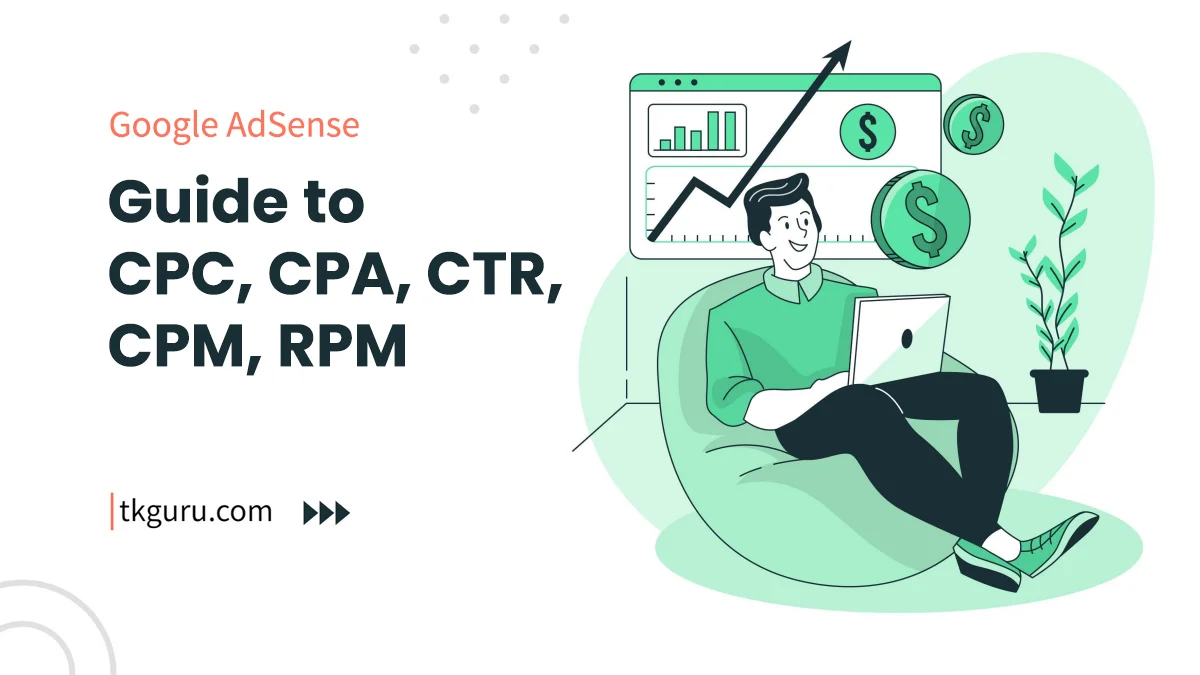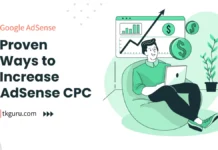Advertisements
Ratings

Guide to CPC, CPA, CTR, CPM, RPM – In the ever-evolving landscape of digital marketing and online content monetization, understanding and effectively harnessing key metrics are essential for success.
Among the plethora of metrics available, five stand out as fundamental pillars of measurement and optimization: CPC, CPA, CTR, CPM, and RPM.
Cost Per Click (CPC) quantifies the expense advertisers incur for each click on their digital ads, making it a critical metric for budget management and Return on Investment (ROI) assessment.
Cost Per Acquisition (CPA) delves deeper, measuring the cost-effectiveness of campaigns by evaluating the expense of acquiring customers or desired actions, such as sign-ups or purchases.
Click-Through Rate (CTR) provides insights into ad engagement and relevance, offering a window into how effectively ads resonate with target audiences.
Cost Per Mille (CPM), on the other hand, zeroes in on brand awareness campaigns, measuring the cost of displaying ads one thousand times.
Finally, Revenue Per Mille (RPM) plays a pivotal role for content creators and publishers, gauging the revenue earned per one thousand ad impressions and guiding content monetization strategies.
In this comprehensive guide, we delve into each metric, exploring their definitions, calculations, significance, optimization strategies, and real-world examples.
Whether you’re an advertiser aiming to enhance campaign performance or a content creator seeking to maximize revenue, this guide equips you with the knowledge and tools to navigate the digital terrain effectively.
Contents
1. What’s the Difference: CPC, CPA, CTR, CPM, RPM
Here’s a comparison table that highlights the key differences between CPC, CPA, CTR, CPM, and RPM:
| Metric | Full Name | Purpose and Focus | Calculation Method | Significance | Strategies for Optimization | Common Use Cases |
|---|---|---|---|---|---|---|
| CPC | Cost Per Click | Measures the cost of each click on an ad. | CPC = Total Cost of Clicks / Total Clicks | Budget control, ROI evaluation. | Keyword optimization, ad quality improvement. | Paid search, pay-per-click (PPC) ads. |
| CPA | Cost Per Acquisition | Evaluates the cost-effectiveness of acquiring customers. | CPA = Total Cost of Campaign / Total Conversions | Conversion tracking, profitability assessment. | Audience segmentation, conversion rate optimization. | Lead generation, e-commerce. |
| CTR | Click-Through Rate | Measures ad engagement and relevance. | CTR = Total Clicks / Total Impressions | Ad effectiveness, user engagement. | Compelling ad copy, A/B testing. | Display ads, email marketing. |
| CPM | Cost Per Mille | Measures the cost of displaying ads one thousand times. | CPM = Total Cost / Total Impressions * 1,000 | Brand visibility, impressions. | Ad placement optimization, ad quality improvement. | Brand awareness campaigns. |
| RPM | Revenue Per Mille | Measures revenue earned per one thousand ad impressions. | RPM = Total Earnings / Total Impressions * 1,000 | Content monetization, revenue optimization. | Content quality improvement, ad format diversification. | Blogging, content monetization. |
This table provides a quick reference guide for understanding the differences and specific applications of each metric in digital advertising and content monetization.
2. Detailed Explanation: CPC, CPA, CTR, CPM, RPM
2.1 Cost Per Click (CPC)
Definition and Explanation of CPC Cost Per Click (CPC) is a fundamental metric in digital advertising. It represents the amount advertisers pay each time a user clicks on their ad. In other words, it quantifies the cost of driving traffic to your website or landing page through paid ads.
How CPC is Calculated Calculating CPC is straightforward. You can determine it using the following formula:
Let’s illustrate this with an example:
Suppose you run a Google Ads campaign, and your total ad spend is $500. Over the course of the campaign, your ads received 1,000 clicks. Using the formula, your CPC would be:
CPC = \frac{500}{1,000} = $0.50 per click
This means, on average, you paid $0.50 for each click generated by your ads.
Importance of CPC in Advertising Campaigns Understanding CPC is crucial for advertisers as it directly impacts budget management and Return on Investment (ROI). By knowing your CPC, you can allocate your advertising budget effectively, ensuring you get the most value for your investment.
For instance, if you have a limited budget, you may want to focus on keywords or ad placements that have a lower CPC, allowing you to stretch your budget further.
Strategies for Reducing CPC Reducing CPC can significantly improve the efficiency of your ad campaigns. Here are some strategies to consider:
- Improve Ad Quality: High-quality ads with relevant keywords tend to have lower CPC. Focus on creating compelling ad copy and optimizing ad extensions.
- Keyword Optimization: Regularly review and refine your keyword list. Eliminate non-performing keywords and bid more aggressively on high-converting ones.
- Geo-Targeting: Target specific geographic regions to reach your ideal audience. This can help reduce CPC by eliminating clicks from less relevant areas.
- Ad Scheduling: Adjust ad schedules to show ads during times when your target audience is most active. Avoid showing ads during periods of low conversion rates.
- Landing Page Optimization: Ensure that your landing pages are optimized for conversion. A well-designed landing page can improve click-through rates, thus reducing CPC over time.
Case Study: CPC Optimization To illustrate the impact of CPC optimization, let’s look at a real-world example. Suppose a small e-commerce business was spending $2.00 per click on their ads. After implementing the strategies mentioned above, their CPC decreased to $1.25 per click. This resulted in a 37.5% reduction in advertising costs while maintaining a consistent level of traffic. As a result, the business was able to allocate more of its budget to other marketing efforts and saw a boost in overall profitability.
2.2 Cost Per Acquisition (CPA)
Definition and Explanation of CPA Cost Per Acquisition (CPA) is another critical metric, particularly for businesses focused on conversions. CPA measures the cost of acquiring a new customer or a desired action, such as a sign-up or purchase, through advertising campaigns. In essence, it quantifies the efficiency of your advertising spend in driving specific actions.
How CPA is Calculated Calculating CPA is straightforward. The formula is:
Let’s use an example to clarify:
Suppose you’re running a Facebook Ads campaign with a total expenditure of $1,000. During the campaign, you received 100 conversions (e.g., purchases or sign-ups). Using the formula, your CPA would be:
CPA = \frac{1,000}{100} = $10 per conversion
This means, on average, you spent $10 to acquire each customer or desired action.
Significance of CPA in Measuring Campaign Efficiency CPA is a critical metric when it comes to assessing the efficiency and profitability of your advertising campaigns. It helps you determine whether the cost of acquiring customers or actions aligns with your business goals and revenue expectations.
For instance, if your product has a fixed profit margin, you’ll want to ensure that your CPA remains below that margin to maintain profitability. If your CPA is too high, it may indicate that you need to refine your targeting or ad creative to attract more qualified leads or customers.
Tactics for Lowering CPA Lowering CPA is a primary goal for many advertisers, as it directly impacts profitability. Here are some effective tactics:
- Audience Segmentation: Refine your target audience to reach those most likely to convert. Use demographic, behavioral, and geographic targeting to narrow down your audience.
- Ad Creative Optimization: A/B test ad creatives to identify the most engaging and persuasive messaging. High-converting ads can reduce CPA.
- Conversion Rate Optimization (CRO): Enhance the user experience on your landing pages to boost conversion rates. A higher conversion rate means a lower CPA.
- Budget Reallocation: Allocate more budget to campaigns or ad sets that are performing well and delivering a lower CPA. Pause or adjust poorly performing campaigns.
- Keyword and Ad Group Refinement: Continuously optimize your keyword lists and ad groups. Focus on high-converting keywords and eliminate underperforming ones.
Real-World Example: Improving CPA Consider a scenario where a digital marketing agency was running a Google Ads campaign for a client in the e-commerce sector. Initially, their CPA was $20 per conversion, which was eating into the client’s profit margins.
After implementing audience segmentation, refining ad creatives, and optimizing landing pages, they managed to reduce the CPA to $12 per conversion.
This 40% reduction significantly improved the client’s profitability, allowing them to reinvest in expanding their advertising efforts.
2.3 Click-Through Rate (CTR)
Definition and Explanation of CTR Click-Through Rate (CTR) is a crucial metric in the world of digital advertising. It quantifies the effectiveness of your ad campaigns in generating clicks. Essentially, CTR is the ratio of users who click on your ad to the number of users who saw it (impressions).
How CTR is Calculated Calculating CTR is straightforward. The formula is:
Let’s break this down with an example:
Suppose your display ad received 5,000 impressions, and it was clicked on 250 times. Using the formula, your CTR would be:
=250×100/5,000
This means that 5% of users who saw your ad clicked on it.
The Role of CTR in Gauging Ad Effectiveness CTR is a key performance indicator (KPI) that helps advertisers gauge the effectiveness of their ad campaigns. It provides insights into how well your ad resonates with your target audience and whether it’s compelling enough to prompt action.
Advertisers often use CTR to measure the relevance and quality of their ad creatives, ad copy, and targeting strategies.
A high CTR generally indicates that your ads are engaging and resonate with users, while a low CTR may suggest room for improvement.
Methods for Boosting CTR Boosting CTR is a common goal for advertisers, as it can lead to more clicks and potentially lower CPC. Here are some effective strategies:
- Compelling Ad Copy: Write persuasive and relevant ad copy that encourages users to click. Highlight unique selling points and benefits.
- Ad Extensions: Utilize ad extensions to provide additional information and incentives. Extensions can increase the visibility and appeal of your ads.
- Keyword Optimization: Ensure your keywords are relevant to your ad group and landing page. Irrelevant keywords can lead to low CTR.
- A/B Testing: Continuously test different ad variations to identify what resonates best with your audience. This includes testing headlines, images, and calls to action.
- Negative Keywords: Use negative keywords to filter out irrelevant traffic. This can improve CTR by ensuring your ads are shown to the most relevant users.
CTR Analysis with Practical Insights Let’s look at a practical example of CTR analysis. Suppose you run two different ad creatives for the same product. Ad A has a CTR of 3%, while Ad B has a CTR of 6%.
Analyzing this data, you can conclude that Ad B is more effective at engaging users and driving clicks. This insight can guide you in creating future ad campaigns and choosing the best-performing ad creatives.
2.4 Cost Per Mille (CPM)
Definition and Explanation of CPM Cost Per Mille (CPM), often referred to as “cost per thousand impressions,” measures the cost of displaying an ad one thousand times (impressions). Unlike CPC, which focuses on clicks, CPM is primarily used in brand awareness campaigns where the goal is to reach as many users as possible.
How CPM is Computed Calculating CPM is straightforward. The formula is:
Let’s use an example to illustrate:
Suppose you run a display ad campaign with a total cost of $500 and the ads receive 100,000 impressions. Using the formula, your CPM would be:
CPM = \frac{500}{100,000} \times 1,000 = $5 CPM
This means you’re paying $5 for every 1,000 ad impressions.
The Relevance of CPM in Brand Awareness Campaigns CPM is particularly relevant in brand-building campaigns, where the primary goal is to increase brand visibility and recognition.
In such campaigns, the focus is not on immediate conversions or clicks but on reaching a broad audience to create brand awareness.
For example, if you’re launching a new product and want to ensure that as many people as possible see your ad, CPM-based campaigns can help you achieve this goal.
Techniques for Reducing CPM While CPM campaigns are not focused on click-throughs or conversions, advertisers still aim to minimize costs and get the most value from their ad spend. Here are some techniques to reduce CPM:
- Ad Placement Optimization: Choose ad placements that are more cost-effective. Analyze the performance of different placements to identify those with lower CPM.
- Audience Targeting: Refine your audience targeting to reach users who are more likely to engage with your ad. This can lead to higher click-through rates and lower CPM.
- Ad Quality: Ensure your ad creative is visually appealing and engaging. High-quality, relevant ads are more likely to be clicked on, which can indirectly lower CPM.
- Frequency Capping: Set frequency caps to limit how often the same user sees your ad. This can prevent ad fatigue and reduce CPM.
- Ad Scheduling: Adjust the timing of your ad displays to reach your target audience when they are most active and responsive.
CPM Case Study: Cost-Saving Strategies Consider a scenario where an online clothing retailer was running a CPM-based campaign to introduce a new clothing line.
Initially, their CPM was $10, which they found to be relatively high for their budget. After optimizing ad placements, refining audience targeting, and improving ad quality, they managed to reduce their CPM to $6.
This not only saved them money but also allowed them to reach a larger audience within their budget constraints.
2.5 Revenue Per Mille (RPM)
Definition and Explanation of RPM Revenue Per Mille (RPM) is a vital metric for content creators, bloggers, and publishers. It measures the revenue earned per one thousand ad impressions. In essence, RPM tells you how much money you can expect to earn for every 1,000 times an ad is displayed on your website or platform.
How RPM is Determined Calculating RPM is straightforward. The formula is:
Let’s use an example to illustrate:
Suppose you run a blog that displays ads, and over a month, your total earnings from ads are $500. During that time, your blog receives 200,000 ad impressions. Using the formula, your RPM would be:
RPM = \frac{500}{200,000} \times 1,000 = $2.50 RPM
This means you’re earning $2.50 for every 1,000 ad impressions on your blog.
RPM’s Significance in Content Monetization RPM is of paramount importance for content creators and publishers who monetize their websites or platforms through ads. It provides a clear picture of how effectively your content generates revenue through advertising.
For content creators, understanding RPM is essential for optimizing content strategies and maximizing ad revenue. A higher RPM indicates that your content is attracting valuable advertisers and engaging users effectively.
Approaches to Increase RPM Increasing RPM is a primary goal for content creators, as it directly impacts revenue generation. Here are some effective approaches:
- Content Quality: Create high-quality, engaging content that attracts a desirable audience. Valuable content often leads to higher RPM as advertisers are willing to pay more to reach engaged users.
- Ad Placement Optimization: Experiment with ad placements to find the most effective positions for maximizing clicks and revenue. Consider using responsive ad units that adapt to different screen sizes.
- Ad Format Diversification: Offer a variety of ad formats, such as display ads, native ads, and video ads. Diversifying ad formats can attract a wider range of advertisers willing to pay higher rates.
- Ad Mediation: Use ad mediation platforms that automatically optimize ad placement and ad networks to maximize RPM.
- Audience Growth: Focus on growing your audience and increasing traffic to your content. More traffic can lead to more ad impressions and, consequently, higher RPM.
Real-World Example: RPM Enhancement Imagine a niche blog dedicated to travel tips and recommendations. Initially, the blog had an RPM of $1.50, which was relatively low.
After implementing content quality improvements, optimizing ad placements, and diversifying ad formats, the blog managed to increase its RPM to $3.50.
This 133% increase in RPM significantly boosted the blog owner’s monthly ad revenue, making the platform more profitable.
3. Comparing and Contrasting Metrics
Overview of When to Use Each Metric Understanding when to use each metric is essential for effective digital advertising and content monetization. Here’s a brief overview of when to use each metric:
- CPC (Cost Per Click): Use CPC when your primary goal is to drive traffic and clicks to your website or landing page, and you want to control the cost of each click.
- CPA (Cost Per Acquisition): CPA is ideal when your focus is on conversions or actions, such as sign-ups or purchases, and you want to measure the cost-effectiveness of your advertising campaigns.
- CTR (Click-Through Rate): CTR is crucial for assessing the effectiveness of ad creatives and targeting strategies, especially when you aim to maximize user engagement.
- CPM (Cost Per Mille): CPM is best suited for brand awareness campaigns where the goal is to maximize impressions and reach a broad audience.
- RPM (Revenue Per Mille): RPM is essential for content creators and publishers looking to monetize their content through advertising, helping them optimize revenue generation.
Advantages and Limitations of Each Metric Each metric has its strengths and limitations. Here’s a brief overview:
- CPC: Advantages include control over click costs, while limitations include a focus on clicks rather than conversions.
- CPA: Advantages include a clear focus on conversions, while limitations include potential fluctuations in conversion rates.
- CTR: Advantages include measuring ad engagement, while limitations include a lack of insight into conversions or revenue.
- CPM: Advantages include brand exposure, while limitations include a lack of focus on clicks or conversions.
- RPM: Advantages include revenue measurement, while limitations include a narrow focus on content monetization.
How These Metrics Interact and Influence One Another It’s important to note that these metrics are interconnected and can influence one another. For example:
- A high CTR may lead to a lower CPC as Google and other ad platforms reward ads that generate engagement with lower click costs.
- Reducing CPM through optimized ad placements can indirectly impact RPM by increasing ad revenue.
- Lowering CPA can improve overall campaign efficiency and potentially result in higher RPM for publishers.
Understanding these interactions allows advertisers and content creators to make informed decisions when optimizing their campaigns and content strategies.
Selecting the Most Appropriate Metric for Specific Campaign Goals Selecting the right metric depends on your specific campaign goals:
- If your goal is to drive website traffic, focus on CPC.
- For maximizing conversions, CPA is the metric of choice.
- To assess ad engagement and relevance, CTR is crucial.
- In brand awareness campaigns, prioritize CPM.
- For content monetization, RPM provides valuable revenue insights.
Choosing the appropriate metric ensures that your campaigns and content strategies align with your objectives and deliver the desired results.
4. Tools and Platforms for Tracking and Analyzing Metrics
List of Popular Digital Marketing Tools Several digital marketing tools and platforms can help you track and analyze metrics effectively. Here are some popular options:
- Google Ads: Ideal for managing CPC and CPA campaigns, tracking conversions, and analyzing ad performance.
- Facebook Ads Manager: Useful for running CPC and CPA campaigns on Facebook and Instagram, with in-depth audience targeting options.
- Google Analytics: Offers comprehensive website analytics, including CTR analysis, and provides insights into user behavior.
- AdWords Keyword Planner: Helps with keyword research and optimizing CPC campaigns for relevant keywords.
- Ad Mediation Platforms: For publishers, platforms like AdMob and AdSense can help maximize RPM by optimizing ad networks and placements.
- Email Marketing Platforms: Such as Mailchimp or Constant Contact, can track email campaign metrics like click-through rates.
How to Set Up Tracking for Metrics Setting up tracking for metrics varies depending on the platform or tool you’re using. However, here’s a general guide:
- Choose the Right Platform: Select the advertising platform or analytics tool that aligns with your goals (e.g., Google Ads, Facebook Ads, Google Analytics).
- Install Tracking Codes: For online advertising, ensure that tracking codes (e.g., Google Analytics tracking code, Facebook Pixel) are correctly implemented on your website or landing pages.
- Define Conversion Actions: Specify the conversion actions you want to track (e.g., purchases, sign-ups, form submissions) within the chosen platform.
- Use UTM Parameters: When creating ad campaigns, use UTM parameters to tag URLs. This helps track the source of traffic and campaign performance.
- Configure Analytics Goals: Set up conversion tracking goals within your analytics platform to measure CPA effectively.
- Regularly Monitor Metrics: Continuously monitor and analyze your metrics to identify trends and opportunities for optimization.
Analyzing Data to Derive Actionable Insights Analyzing data is essential for deriving actionable insights and optimizing your campaigns or content strategies. Here’s how to approach data analysis:
- Regular Reporting: Create regular reports to track the performance of your campaigns or content. Look for trends over time.
- Segmentation: Segment your data by different dimensions (e.g., time, demographics, devices) to identify patterns.
- A/B Testing: Implement A/B testing for ads, landing pages, or content to determine what works best and refine your approach.
- Benchmarking: Compare your metrics to industry benchmarks to assess how you stack up against competitors.
- Performance Attribution: Understand the role of each metric in the customer journey and how they contribute to overall success.
- Iterative Optimization: Continuously optimize your campaigns or content based on the insights gained from data analysis.
By consistently monitoring and analyzing metrics, you can make data-driven decisions to improve your digital advertising or content monetization strategies.
Conclusion
Recap of the Importance of CPC, CPA, CTR, CPM, and RPM In this comprehensive guide, we’ve delved into the world of digital advertising metrics, covering CPC, CPA, CTR, CPM, and RPM.
These metrics are the building blocks of successful advertising campaigns and content monetization strategies.
- CPC helps you manage your click costs and optimize your budget.
- CPA measures the cost-effectiveness of your campaigns by tracking conversions.
- CTR assesses ad engagement and relevance.
- CPM is essential for brand awareness campaigns focused on impressions.
- RPM provides valuable insights for content creators and publishers looking to monetize their content.
Encouragement to Monitor and Optimize These Metrics To succeed in the dynamic world of digital marketing, continuous monitoring and optimization of these metrics are crucial.
Whether you’re an advertiser aiming to maximize ROI or a content creator seeking to boost revenue, understanding and leveraging these metrics will be key to your success.
Final Thoughts on the Evolving Landscape of Digital Advertising Metrics The digital advertising landscape is constantly evolving.
New technologies, consumer behaviors, and advertising platforms continually reshape the metrics and strategies marketers and content creators use. Staying informed and adaptable is essential to thrive in this ever-changing environment.
As you embark on your digital advertising or content monetization journey, remember that these metrics are your compass, guiding you toward success.
By mastering CPC, CPA, CTR, CPM, and RPM, you can make informed decisions, optimize your efforts, and achieve your goals in the digital realm.
Guide to CPC, CPA, CTR, CPM, RPM FAQs
What is CPC, CPA, CTR, CPM, and RPM, and why are they important in digital advertising?
CPC (Cost Per Click), CPA (Cost Per Acquisition), CTR (Click-Through Rate), CPM (Cost Per Mille), and RPM (Revenue Per Mille) are key metrics in digital advertising.
CPC and CPA relate to the cost of acquiring a click or a conversion, CTR measures user engagement, CPM quantifies the cost per thousand impressions, and RPM indicates earnings per thousand page views. These metrics help advertisers assess campaign performance and publishers evaluate revenue generation.
How can I improve my CPC in digital advertising?
To enhance CPC, focus on keyword optimization, ad relevance, quality score improvement, and targeted audience selection. A/B testing, refining ad copy, and optimizing landing pages can also boost CPC.
What strategies can I employ to increase my CTR for online ads?
To raise CTR, craft compelling ad headlines and descriptions, use eye-catching visuals, employ relevant keywords, and conduct A/B testing. Targeted ad placements and audience segmentation can also enhance CTR.
What are some common methods for optimizing CPM and RPM for publishers?
Publishers can optimize CPM and RPM by delivering high-quality content, increasing website traffic, using ad networks or exchanges, implementing header bidding, and experimenting with ad formats and placements. Additionally, improving user experience and mobile optimization can positively impact CPM and RPM.
How does CPA differ from CPC in digital advertising, and which is more suitable for my campaign?
CPA focuses on the cost per acquisition or conversion, while CPC centers on the cost per click. CPA is ideal for performance-based campaigns where the main goal is to acquire leads or conversions.
CPC suits campaigns where the primary aim is to drive traffic or increase brand visibility. The choice depends on your campaign objectives and budget allocation.
| Web Hosting | Website |
| WordPress | Google Adsense |
| SEO | Affiliate Marketing |
| Blogging | YouTube |
Recent Posts
- 9 Proven Ways to Increase Page CTR by 50%
- 9 Proven Ways to Increase Page RPM by 50%
- A Detailed Guide to CPC, CPA, CTR, CPM, RPM
- Top 10 High CPC Countries: Maximizing Ad Revenue in Lucrative Markets
Related Tags
cpa cpm, cpc cpv advertising models, cpm, cpc, cpa in digital marketing, ctr: cpc cpm formula, cpm / ctr cpc calculator, cpm or cpc which is better, cpc formula, cpc vs cpa, cpc and cpm bids cannot be edited






